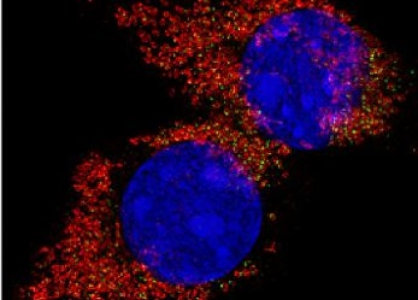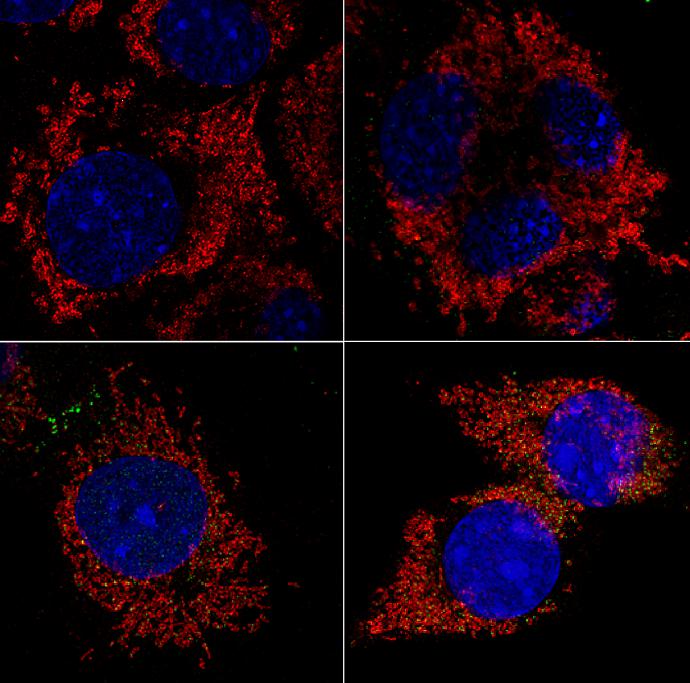A new role of mitochondria in tumor growth
Wed Dec 05 00:00:00 CET 2018
Sat May 02 21:44:33 CEST 2020 | Sat May 02 21:44:33 CEST 2020 - Sat May 02 21:44:33 CEST 2020

Researchers from the Institute of Biotechnology of the ASCR at the BIOCEV recently showed that cancer cells with mitochondrial DNA (mtDNA) disorders must regain respiration by "stealing" mitochondria with undamaged mtDNA from surrounding, non-cancerous cells after introduction into laboratory mice.
"Mitochondria are small intracellular formations that produce energy in the cell necessary for a number of processes, including cell growth, an essential attribute of tumor tissue," says prof. Jiří Neužil, Head of the Molecular Therapy Laboratory. "The production of energy in mitochondria depends on mitochondrial 'respiration', ie the consumption of oxygen. An important property of mitochondria is the presence of its own hereditary information - mtDNA, which is necessary for the respiration process, "adds prof. He didn't use it.
However, the link between the inability to form tumors and the lack of energy has not been proven. It was necessary to start looking for a new way. During it, the researchers discovered that the reason is the involvement of mitochondrial respiration in the formation of pyrimidines - the building blocks of DNA, the formation of which is essential for cell growth.
Cancer cells with mtDNA disorder do not respond and therefore cannot form pyrimidines. This blocks their growth and suppresses the enlargement of the whole tumor. After obtaining mitochondria from surrounding cells and restoring respiration, cancer cells can produce pyrimidines and grow again. The tumor begins to regenerate again.
"Our discovery, published in the prestigious journal Cell Metabolism, is very interesting both in terms of basic research and its possible transfer to clinical practice," explains prof. Jiří Neužil application potential of new knowledge. "The above mechanism could be shared by many types of tumors, because the universal property of a cancer cell is rapid growth, which requires intensive production of pyrimidines. We believe that this discovery will lead to the design of new, broad-spectrum anti-cancer agents. "
Publikacation:
Bajzikova, M., Kovarova, J., Coelho, A.R., Boukalova, S., Oh, S., Rohlenova, K., Svec, D., Hubackova, S., Endaya, B., Judasova, K., Bezawork-Geleta, A., Kluckova, K., Chatre, L., Zobalova, R., Novakova, A., Vanova, K., Ezrova, Z., Maghzal, G.J., Novais, S.M., Olsinova, M., Krobova, L., An, Y.J., Davidova, E., Nahacka, Z., Sobol, M., Cunha-Oliveira, T., Sandoval-Acuña, C., Strnad, H., Zhang, T., Huynh, T., Serafim, T.L., Hozak, P., Sardao, V.A., Koopman, W.J.H., Ricchetti, M., Oliveira, P.J., Kolar, F., Kubista, M., Truksa, J., Dvorakova-Hortova, K., Pacak, K., Gurlich, R., Stocker, R., Zhou, Y., Berridge, M.V., Park, S., Dong, L., Rohlena, J., Neuzil, J. Reactivation of Dihydroorotate Dehydrogenase-Driven Pyrimidine Biosynthesis Restores Tumor Growth of Respiration-Deficient Cancer Cells. Cell Metabolism, 29: 1–18, March 5, 2019. https://doi.org/10.1016/j.cmet.2018.10.014

Rakovinné buňky bez mitochondriální DNA si po vnesení do hostitele (myši) postupně obnoví mtDNA.
Na obrázku jsou ukázány buňky na počátku a 10, 20 a 60 dní po vnesení do hostitele.
Modrá barva označuje jádra, červená mitochondrie a zelená mtDNA.
